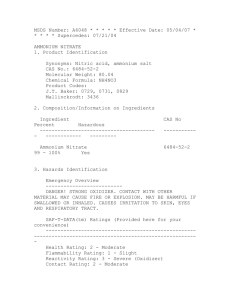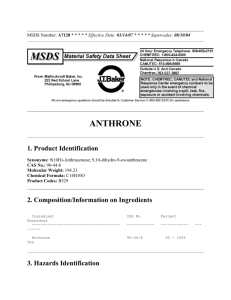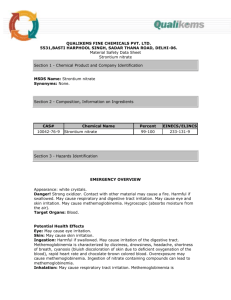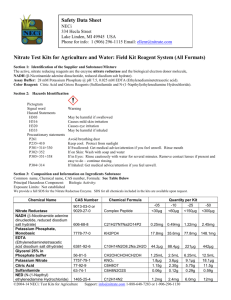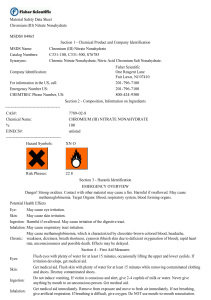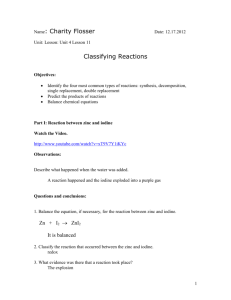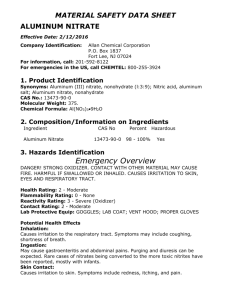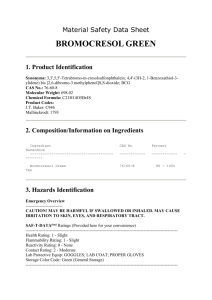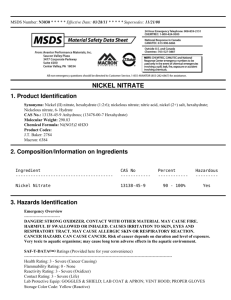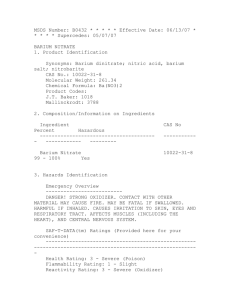zinc nitrate
advertisement
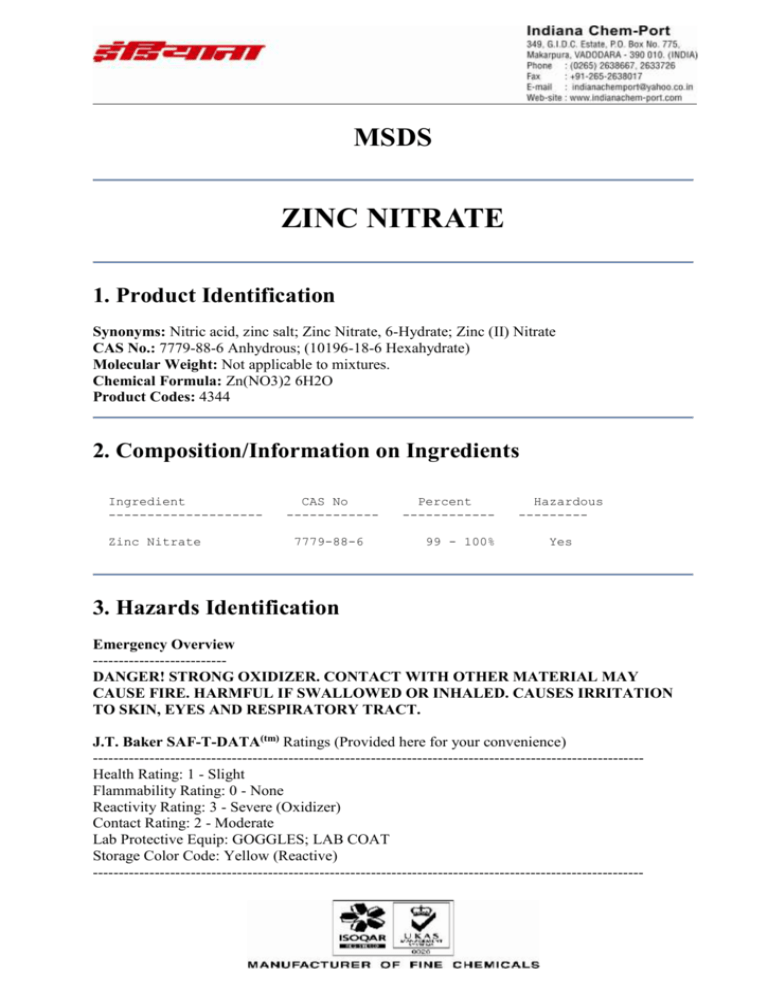
MSDS ZINC NITRATE 1. Product Identification Synonyms: Nitric acid, zinc salt; Zinc Nitrate, 6-Hydrate; Zinc (II) Nitrate CAS No.: 7779-88-6 Anhydrous; (10196-18-6 Hexahydrate) Molecular Weight: Not applicable to mixtures. Chemical Formula: Zn(NO3)2 6H2O Product Codes: 4344 2. Composition/Information on Ingredients Ingredient -------------------Zinc Nitrate CAS No -----------7779-88-6 Percent -----------99 - 100% Hazardous --------Yes 3. Hazards Identification Emergency Overview -------------------------DANGER! STRONG OXIDIZER. CONTACT WITH OTHER MATERIAL MAY CAUSE FIRE. HARMFUL IF SWALLOWED OR INHALED. CAUSES IRRITATION TO SKIN, EYES AND RESPIRATORY TRACT. J.T. Baker SAF-T-DATA(tm) Ratings (Provided here for your convenience) ----------------------------------------------------------------------------------------------------------Health Rating: 1 - Slight Flammability Rating: 0 - None Reactivity Rating: 3 - Severe (Oxidizer) Contact Rating: 2 - Moderate Lab Protective Equip: GOGGLES; LAB COAT Storage Color Code: Yellow (Reactive) ----------------------------------------------------------------------------------------------------------- Potential Health Effects ---------------------------------Inhalation: Causes irritation to the respiratory tract. Symptoms may include coughing, shortness of breath. Methemoglobinemia may occur. Ingestion: Causes irritation of the gastrointestinal tract. If appreciable amounts are ingested, abdominal pain, cramps and nausea may result together with faintness and bluish lips and skin (methemoglobinemia). Skin Contact: Causes irritation to skin. Symptoms include redness, itching, and pain. Eye Contact: Irritant. Causes redness, tears and pain, possibly blurred vision. Chronic Exposure: Zinc salts are eliminated fairly promptly, making chronic effects less than acute. Aggravation of Pre-existing Conditions: No information found. 4. First Aid Measures Inhalation: Remove to fresh air. If not breathing, give artificial respiration. If breathing is difficult, give oxygen. Get medical attention. Ingestion: If swallowed, DO NOT INDUCE VOMITING. Give large quantities of water. Never give anything by mouth to an unconscious person. Get medical attention immediately. Skin Contact: Immediately flush skin with plenty of water for at least 15 minutes. Remove contaminated clothing and shoes. Get medical attention. Wash clothing before reuse. Thoroughly clean shoes before reuse. Eye Contact: Immediately flush eyes with plenty of water for at least 15 minutes, lifting lower and upper eyelids occasionally. Get medical attention immediately. 5. Fire Fighting Measures Fire: Not combustible, but substance is a strong oxidizer and its heat of reaction with reducing agents or combustibles may cause ignition. Increases flammability of any combustible substance in contact with it. Explosion: May act as initiation source for dust or vapor explosions. Fire Extinguishing Media: Water or water spray in early stages of fire. Foam or dry chemical may also be used. Special Information: In the event of a fire, wear full protective clothing and NIOSH-approved self-contained breathing apparatus with full facepiece operated in the pressure demand or other positive pressure mode. 6. Accidental Release Measures Remove all sources of ignition. Ventilate area of leak or spill. Wear appropriate personal protective equipment as specified in Section 8. Spills: Clean up spills in a manner that does not disperse dust into the air. Use non-sparking tools and equipment. Reduce airborne dust and prevent scattering by moistening with water. Pick up spill for recovery or disposal and place in a closed container. US Regulations (CERCLA) require reporting spills and releases to soil, water and air in excess of reportable quantities. The toll free number for the US Coast Guard National Response Center is (800) 424-8802. 7. Handling and Storage Keep in a tightly closed container, stored in a cool, dry, ventilated area. Protect against physical damage and moisture. Isolate from any source of heat or ignition. Avoid storage on wood floors. Separate from incompatibles, combustibles, organic or other readily oxidizable materials. Containers of this material may be hazardous when empty since they retain product residues (dust, solids); observe all warnings and precautions listed for the product. 8. Exposure Controls/Personal Protection Airborne Exposure Limits: None established. Ventilation System: A system of local and/or general exhaust is recommended to keep employee exposures as low as possible. Local exhaust ventilation is generally preferred because it can control the emissions of the contaminant at its source, preventing dispersion of it into the general work area. Please refer to the ACGIH document, Industrial Ventilation, A Manual of Recommended Practices, most recent edition, for details. Personal Respirators (NIOSH Approved): For conditions of use where exposure to dust or mist is apparent and engineering controls are not feasible, a particulate respirator (NIOSH type N95 or better filters) may be worn. If oil particles (e.g. lubricants, cutting fluids, glycerine, etc.) are present, use a NIOSH type R or P filter. For emergencies or instances where the exposure levels are not known, use a full-face positivepressure, air-supplied respirator. WARNING: Air-purifying respirators do not protect workers in oxygen-deficient atmospheres. Skin Protection: Wear impervious protective clothing, including boots, gloves, lab coat, apron or coveralls, as appropriate, to prevent skin contact. Eye Protection: Use chemical safety goggles and/or full face shield where dusting or splashing of solutions is possible. Maintain eye wash fountain and quick-drench facilities in work area. 9. Physical and Chemical Properties Appearance: Colorless or white crystals or flakes. Odor: Slight nitric acid odor. Solubility: 200 g/100 g water. Density: 2.07 pH: No information found. % Volatiles by volume @ 21C (70F): 0 Boiling Point: ca. 105C (ca. 221F) Melting Point: ca. 36C (ca. 97F) Vapor Density (Air=1): No information found. Vapor Pressure (mm Hg): No information found. Evaporation Rate (BuAc=1): Not applicable. 10. Stability and Reactivity Stability: Stable under ordinary conditions of use and storage. Hazardous Decomposition Products: Oxides of nitrogen and toxic metal fumes may form when heated to decomposition. Hazardous Polymerization: Will not occur. Incompatibilities: Metal powders, cyanides, sodium hypophosphite, stannous chloride, phosphorus, thiocyanates, carbon, metallic sulfides, sulfur, organic materials. Substance is capable of reacting rapidly with reducing agents and combustible materials at elevated temperatures. Conditions to Avoid: Heat, flames, ignition sources and incompatibles. 11. Toxicological Information Oral rat LD50 = 1400 mg/Kg. --------\Cancer Lists\-------------------------------------------------------NTP Carcinogen--Ingredient Known Anticipated IARC Category ----------------------------------------------------Zinc Nitrate (7779-88-6) No No None 12. Ecological Information Environmental Fate: This material is not expected to significantly bioaccumulate. Environmental Toxicity: This material is expected to be toxic to aquatic life. 13. Disposal Considerations Whatever cannot be saved for recovery or recycling should be handled as hazardous waste and sent to a RCRA approved waste facility. Processing, use or contamination of this product may change the waste management options. State and local disposal regulations may differ from federal disposal regulations. Dispose of container and unused contents in accordance with federal, state and local requirements. 14. Transport Information Domestic (Land, D.O.T.) ----------------------Proper Shipping Name: ZINC NITRATE Hazard Class: 5.1 UN/NA: UN1514 Packing Group: II Information reported for product/size: 350LB International (Water, I.M.O.) ----------------------------Proper Shipping Name: ZINC NITRATE Hazard Class: 5.1 UN/NA: UN1514 Packing Group: II Information reported for product/size: 350LB 15. Regulatory Information --------\Chemical Inventory Status - Part 1\------------------------------Ingredient TSCA EC Japan Australia ---------------------------------------------- ---- --- ----- -------Zinc Nitrate (7779-88-6) Yes Yes Yes Yes --------\Chemical Inventory Status - Part 2\--------------------------------Canada-Ingredient Korea DSL NDSL Phil. ----------------------------------------------- ----- ------ ----Zinc Nitrate (7779-88-6) Yes Yes No Yes --------\Federal, State & International Regulations - Part 1\--------------SARA 302------SARA 313---Ingredient RQ TPQ List Chemical Catg. --------------------------------------- ---------- -----------Zinc Nitrate (7779-88-6) No No No Zinc cmpd/ni --------\Federal, State & International Regulations - Part 2\--------------RCRA-TSCAIngredient CERCLA 261.33 8(d) ----------------------------------------- ---------------Zinc Nitrate (7779-88-6) 1000 No No Chemical Weapons Convention: No TSCA 12(b): No SARA 311/312: Acute: Yes Chronic: No Fire: No Reactivity: Yes (Pure / Solid) CDTA: No Pressure: No Australian Hazchem Code: 2Y Poison Schedule: None allocated. WHMIS: This MSDS has been prepared according to the hazard criteria of the Controlled Products Regulations (CPR) and the MSDS contains all of the information required by the CPR. 16. Other Information NFPA Ratings: Health: 3 Flammability: 0 Reactivity: 0 Other: Oxidizer Label Hazard Warning: DANGER! STRONG OXIDIZER. CONTACT WITH OTHER MATERIAL MAY CAUSE FIRE. HARMFUL IF SWALLOWED OR INHALED. CAUSES IRRITATION TO SKIN, EYES AND RESPIRATORY TRACT. Label Precautions: Keep from contact with clothing and other combustible materials. Store in a tightly closed container. Avoid contact with eyes, skin and clothing. Wash thoroughly after handling. Avoid breathing dust. Use only with adequate ventilation. Label First Aid: If swallowed, DO NOT INDUCE VOMITING. Give large quantities of water. Never give anything by mouth to an unconscious person. If inhaled, remove to fresh air. If not breathing, give artificial respiration. If breathing is difficult, give oxygen. In case of contact, immediately flush eyes or skin with plenty of water for at least 15 minutes while removing contaminated clothing and shoes. Wash clothing before reuse. In all cases call a physician. Product Use: Laboratory Reagent. Revision Information: MSDS Section(s) changed since last revision of document include: 1. Disclaimer: ***************************************************************************** INDIANA CHEM-PORT, provides the information contained herein in good faith but makes no representation as to its comprehensiveness or accuracy. This document is intended only as a guide to the appropriate precautionary handling of the material by a properly trained person using this product. Individuals receiving the information must exercise their independent judgment in determining its appropriateness for a particular purpose. *****************************************************************************
